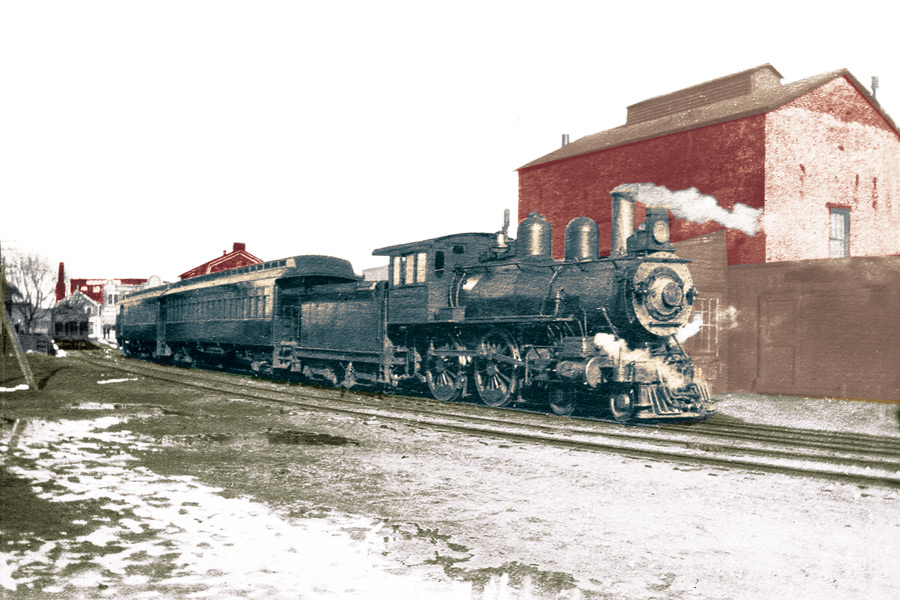Tracking Railroad History in Sag Harbor – The Original 'End'

People now call Montauk “The End,” and for obvious reasons. Montauk is the end of Long Island, the end of the road and the last stop on the Long Island Rail Road (LIRR).
There was a time when, if you came out to the South Fork by rail, Sag Harbor was “The End.” In the late 1860s, the expanding Long Island Rail Road—not seeing any value in extending itself in a straight line after Bridgehampton just to end up in the wilds of East Hampton and beyond—laid track veering north after Bridgehampton and terminating in the port village of Sag Harbor. And so, from 1870 to 1895, Sag Harbor was the LIRR’s last station stop on the South Fork. This might surprise some people, because the train doesn’t even GO to Sag Harbor anymore.

A new exhibition at the Sag Harbor Historical Society’s Annie Cooper Boyd House museum documents the largely vanished history of rail transportation to Sag Harbor. The exhibit, organized by Jean Held and open through August 31, provides lots of fun information for train buffs and casual observers alike.
“I wanted to show and document the railroad era in Sag Harbor. Sag Harbor’s gone through so many different eras, which isn’t so true of other East End villages,” Held says.

The railroad should have been a boon for Sag Harbor in 1870. It arrived as the once thriving whaling village had gone into steep decline, as petroleum replaced the use of whale oil. The rudimentary roads leading to Sag Harbor made reaching the village on land difficult at the best of times, and nearly impossible in bad weather—a state of affairs that did nothing to improve Sag Harbor’s economic situation. It was hoped that the arrival of the railroad would spur industry. Certainly the establishment of Fahy’s watchcase factory, which relocated to the village from New Jersey in 1881, was a step toward Sag Harbor’s revitalization, but was it enough? Time marched on, and while tourism thrived, the railroad connection failed to live up to its promise of turning Sag Harbor into an industrial metropolis.

Sag Harbor became more of a way-station, with passengers transferring from trains to boats as they continued on to East Hampton and beyond. Then, in 1895, the LIRR extended the railroad straight out of Bridgehampton to East Hampton and all the way to Montauk, turning the Sag Harbor line into a spur while simultaneously depriving it of one of its central functions. From 1927, the LIRR ran a tiny, unprofitable “Toonerville Trolley” (single-car train) between Bridgehampton and Sag Harbor. This service was discontinued in 1939, and the Sag Harbor spur was abandoned.

Today, not much is left to indicate that a train ever ran to Sag Harbor. The train station that stood on Long Island Avenue is gone, torn down in 1965—there’s a drive-thru bank standing close to the spot that the station occupied. The former depot building that once stood nearby has survived; it was moved to Spring Street and today houses the Sag Harbor Garden Center. The railroad track is long gone, totally removed in the 1940s—the steel probably used to help the war effort. There are some portions of the rail bed that are still visible in the Long Pond Greenbelt east of the Bridgehampton-Sag Harbor Turnpike. So, for those who want to see solid evidence of a Sag Harbor train—the depot building and the portions of rail bed—are about all that remains.
Otherwise, feast your eyes on these pictures of the glory days of rail in Sag Harbor. They’re just about the only proof that Sag Harbor ever was “The End.”
Sag Harbor Historical Society’s Annie Cooper Boyd House is located at 174 Main Street in Sag Harbor. Call 631-725-5092, or visit sagharborhistorical.org for more info.










